Undocumented Immigrants
New York City certainly has a lot at stake in the current debate in Congress over the most significant change in immigration policy in decades. More than a third of all New Yorkers are foreign-born. In the year 2000, New York was home to some 2.8 million immigrants, which is more than nine percent of all immigrants in the United States.
But if neither the pro-immigrant demonstrations nor the anti-immigrant rhetoric has ratcheted up here the way it has elsewhere in the country, there are solid reasons for this. The situation is very different in New York City than it is in California and the Southwest.
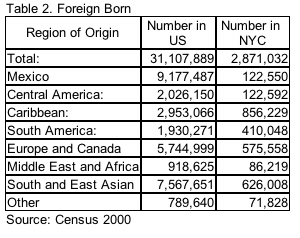
One difference is that the countries of origin in New York City are far more diverse than in other centers of immigration, as I wrote for this page in an article in 2002, "City of the Foreign Born." In Los Angeles, Mexicans account for almost 85 percent of the foreign born. No group in New York City is greater than 13 percent. So the protests in Los Angeles are largely that of one group. "The mobilization in New York City has been slower to develop," El Diario conceded recently. "The immigrant community here is incredibly diverse and, some say, harder to organize."
But the major difference may well be size and visibility of the undocumented. As of 2005, there are estimated to be 652,000 immigrants living illegally in New York City, which constitutes only about six percent of all of the undocumented in the United States. New York City's undocumented immigrants, as its legal immigrants, come from all continents and many countries of origin.
Jeffery Passel, a a leading analyst of immigrants, recently looked at the population of undocumented immigrants for a study by the Pew Hispanic Center. This study uses the so-called residual methodology, which makes it difficult to infer very much about the undocumented except their size. The study estimates that the number of undocumented immigrants in the United States may be 12 million by March 2006, and that they constitute about 30 percent of all immigrants nationwide. In New York City, the undocumented comprise only about 20 percent of all the immigrants here.
Two main groups of undocumented are those who entered the country without valid documents, including people crossing the Southwestern border clandestinely; and those who entered with valid visas but overstayed their visas' expiration or otherwise violated the terms of their admission. Most of New York City's undocumented belong to the latter category.

About 56 percent of unauthorized migrants in the United States come from Mexico. Another 22 percent of the total, come from the rest of Latin America, primarily from Central America. Between 2000 and 2005 the number of unauthorized migrants from Mexico increased by about 1.5 million. Other large increases occurred among unauthorized migrants from Central America (+465,000) and South and East Asia (+365,000).
New York City has many Asian immigrants. But, while the numbers are surely growing, there are still relatively few Mexicans or Central Americans here, compared to the West Coast.
The undocumented are more likely male. Many live in families and nearly two-thirds of their children were born in the United States and are citizens. Unauthorized workers are employed in a variety of occupations, although the distribution of the unauthorized workforce across occupations differs from that of native-born workers. For example, nearly a third of unauthorized workers were employed in service occupations compared to one-sixth of native workers. Unauthorized migrants are underrepresented in white-collar occupations. These facts are true of undocumented in New York City and throughout the United States.
Given the demographics of New York City, and its long-time political traditions, it seems likely that most New Yorkers will remain well disposed towards the city's immigrants, legal or illegal.
Andrew A. Beveridge has taught sociology at Queens College since 1981, done demographic analyses for the New York Times since 1993, and been in charge of Gotham Gazette's demographics topic page since 2000. The opinions expressed are his alone.Â
Transit Workers/Transit Riders; Beginning Lawyers Are Richer; 9 Million New Yorkers?
More than two months after the end of the three-day New York City transit strike, both the attention and the tension have dimmed. But there is still no settlement in place, and indeed some transit workers have signed a petition to vote again on the contract that had been rejected on January 20th by a mere seven votes.
It would be difficult to say with whom the majority of New York bus and subway riders sided, the transit workers or the management of the Metropolitan Transportation Authority. It is a safe bet to say that during the inconvenience of the strike itself, most commuters had little polite to say about either of them.
Since people tend to sympathize with those who seem similar, it is worth looking at the ways in which transit workers resemble, and differ from, transit riders.
Transit Riders
New York City is one of the few places in the United States in which only a minority of people rely on the automobile to get to work. Nationwide, 86 percent of people who live in or near central cities commute by car. In New York City, that number is about 33 percent.
Table 1 offers a breakdown:

It is interesting to note that public transit workers in New York actually commute by automobile at a higher rate than New Yorkers as a whole.
There are also sharp demographic differences among commuters, depending on the means by which they get to work. For instance, those who use commuter rail to come to NYC generally earn more income, live in more affluent households, are more often male, are more likely white, are more often living with a spouse and have graduated from college than those using other means to get to work. They differ substantially from those who drive or ride an automobile, work at home or get to work by other means.

By contrast, those who take public transit are more likely to be black and Hispanic than the other groups. They are less likely to be living with a spouse. They are also likely to have less education. The median income of those using public transit (subway or bus) is about $34,000.
Transit Workers
Public transit workers make a median income that is more than the public they service. Instead of $34,000, they earn a median income of $47,000.
There are other differences as well. A larger fraction of transit workers are male and black than the public at large. They are also less likely to be educated, are as a group older than New Yorkers as a whole, and are more likely to own their own homes and live in married-couple households. Despite their relative lack of education, the arduous nature of transit work coupled with their unionized power has led them to a relatively high income.

How this analysis was done.
This analysis made use of the Public Use Micro-sample data from the IPUMS website. Using a variety of variables it was possible to isolate those who work in the public or private transit industry, as well as those who work in New York City and travel to their jobs in various ways.
Young Lawyers Get $20,000 raises
According to New York Observer, a bidding war has broken out among the major so-called Wall Street or White Shoe law firms. New associates are now being offered $145,000 up from $125,000, where it has been for about 5 years. My earlier column on New York Lawyers still seems to be basically accurate, though the figures have increased.
Nine Million New Yorkers?
Is New York growing so fast that it is likely to reach 9 million population in the next two decades? Using recent projections from some private entities a New York Times story indicates that the Bloomberg administration is planning for it. New York City reached over seven million by 1940 and it took 60 years to reach eight million. Could it really reach nine million by 2025? So far, according to census numbers, New York City is growing more modestly than it did in the 1990s. The census recently changed their estimation methods, but the city usually challenges their estimates and is given credit for a few more thousand people. During that decade the census estimated that the city was only growing about 10,000 per year, but it actually was growing about 60,000. We will probably know more when the new fully implemented American Community Study data are released next August. Until then, the Census will issue a new estimate for the population through July 31, 2005 sometime this spring.
Census Says Keep Counting the Prisoners in Prison
Despite the efforts of many in the redistricting and criminal justice communities the Census Bureau says that prisoners should still be counted at the prison sites and that the data should continue to be added to the counts in many small towns and counties. A rider was added to the census appropriation bill asking for a report on this issue. Not surprisingly the Census Bureau did not want to change a thing. The current method deprived the city of thousands of residents, who were moved upstate along with their power to affect the drawing of legislative lines for Congress, and State Senate and Assembly. But at least one New York State County does not use prisoners when they draw the county legislative lines, they think they distort the power in that county.
Andrew A. Beveridge has taught sociology at Queens College since 1981, done demographic analyses for the New York Times since 1993, and been in charge of Gotham Gazette's demographics topic page since 2000. The opinions expressed are his alone.Â
Teachers In NYC's Institutions Of Higher Learning
Although few people would see New York City as a college town, the truth is that the city has the most institutions of higher learning in the entire nation, as well as the most students -- and the most teachers as well. At least 25,000 academics teach about 425,000 students in the city's 57 colleges and universities.
These teachers do much for the city, not just educating the next generation of New Yorkers, but also enhancing the city's cultural reputation and strengthening its economy.
But what does the city do for them? As a whole, teachers of higher learning in New York earn less than the city's elementary school teachers. This helps explain some of the current turmoil in academia, with a strike by graduate students having resumed at New York University, and stalled contract negotiations between the administration of the City University of New York and the Professional Staff Congress, the 20,000-member union that represents the faculty and staff of the university.
It Doesn’t Pay To Be An Academic
Table 1 (click here) lists most of the institutions of higher learning in New York City, with the numbers of students enrolled, the number of faculty, and their average salary. This varies widely. As a full professor at New York University, you could make $135,000; as an assistant professor at Boricua College, you could make under $35,000. But the truth is, more teachers make toward the lower end than toward the higher. The median income for full-time professors with at least a Master's degree is $57,000 – which is $3,000 less than the median income for all New Yorkers with Master's degrees.
And this is only the full-time faculty; there are no more than 16,000 people who teach full-time in New York at the university level. Another 11,000 who call academia their primary occupation nevertheless teach only part-time; their median income is only $22,000.
Put these two together and the median earnings in the year 2000 of New Yorkers whose primary occupation was academia (and who had at least a Master's degree) was $45,000 – or a thousand dollars less than the median income for elementary and secondary school teachers in the city.

And then there are the many academics who are forced to accept "adjunct positions," which often pay roughly $3,000 per course, or "visiting" (non-permanent) appointments, which also usually are not well paid. (Many of these teachers hold non-academic jobs as well.) In addition, many graduate students do some teaching while pursuing their degrees.
Public Versus Private
There are a wide variety of colleges and schools in New York City. Below, the "conventional" colleges are grouped into four types – City University senior colleges, City University community colleges, private colleges and religious-affiliated colleges – for the purposes of comparing both the number of faculty at each of these types of institutions, and their salaries.
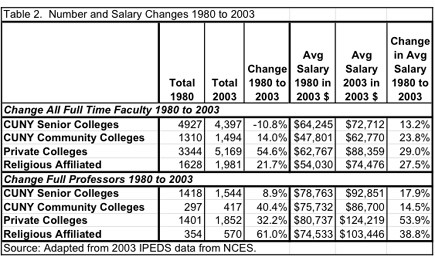
As you can see above, both private and religiously-affiliated institutions of higher learning have overtaken the public university in many ways. While once salaries for full professors (the most experienced and the most sought after) at the senior colleges of City University were competitive with their peers at the private colleges, now they are far less; the ones at CUNY earn on average about $93,000, while those at non-sectarian private colleges in the city are paid an average of about $124,000.
In 1980, those teaching at religiously affiliated private colleges were earning about $75,000 (or four thousand dollars less than CUNY senior faculty); now they earn about $10,000 more per year. Given these data, it is not surprising that CUNY faculty members are severely discontent with their current salary. (For a breakdown college by college of the difference in number and salary of faculty members between 1980 and 2003, click here).
Academics are broadly representative demographically of others with a Masters or higher degree in New York City. Indeed, as Table 3 shows, the major differences between academics and others is that full-time academics have a lower household income than other full-time employed New Yorkers with at least a Masters degree, but other part-time workers live in households with lower incomes than those employed as part-time academics. Other part time workers are much less likely to be male.

Academics in New York City, especially part-time academics are struggling. New York City's large public university in no way is keeping up with the other four-year colleges in the city. Graduate students went on strike at NYU; there are grumblings at Columbia; many CUNY graduate students spend some time in the subway commuting from campus to campus. It is difficult to finish a Ph.D. program, where many students spend five, six, or seven years or more and roughly half leave without the degree . It is difficult to find an academic job, as the recent book Will Teach for Food graphically demonstrates . Swarthmore Professor Timothy Burke's very trenchant Web site "Should I Go to Graduate School?" spells out the perils of an academic career Yet, more academics are produced every year. New York City is still a place that many would be pleased to be if they could find a job, and afford to live here.
A Note on Sources
This column is based upon two sets of public data. The 2000 Census Public Use Micro-Data Samples (PUMS) from the IPUMS site and the Integrated Post-Secondary Education Data System (IPEDS), which includes data collected and maintained by the National Center for Education Statistics, but reported by the institutions. To find academics who worked in New York City, I used various codes from the PUMS data that depicted occupation, industry, type of employer and location of job. I limited my analysis to those with a Master's degree. For the data on colleges and universities, I selected those institutions that awarded at least an Associate Degree, but I did eliminate some that were trade schools or had recently lost accreditation, as well as those that were predominantly professional schools. There may be some differences in definition between 1980 and 2003, and I did not include fringe benefits, but the general patterns of change are robust.
Andrew A. Beveridge has taught sociology at Queens College since 1981, done demographic analyses for the New York Times since 1993, and been in charge of Gotham Gazette's demographics topic page since 2000. The opinions expressed are his alone. Â
Hispanics and the Ferrer Candidacy
Fernando Ferrer was the first candidate of Hispanic descent to run with major party backing for the office of mayor of New York City, and when he lost by a large margin, there was a general consensus among journalists: Ferrer, they said, did poorly among every ethnic group, even -- relatively speaking –- his own.
Some commentators sought to explain this by noting that “Hispanic” no longer means just Puerto Ricans, or even just Puerto Ricans and Dominicans. Hispanic New Yorkers come from many different countries now. Others pointed out that Bloomberg’s polling of voters was very vigorous and very specific, but that it was not based on their ethnic origins. Thus, it was possible to ask seriously whether the mayoral election signaled a new phase in New York City politics -- the beginning of the end of ethnic politics.
There was just one problem with all these explanations and conclusions -- they were based on an inaccurate consensus.
No major news organizations did their own polling; their conclusions about Ferrer’s support was based on an unconventional exit poll.
Now more data are available, including complete voting returns for all 6,000 of New York City's election district, as well as a recent exit poll among immigrants. It turns out that the vast majority of Hispanic voters did in fact choose Ferrer -– at least 80 percent. This demonstrates not just that ethnic politics is alive and well in New York City, but that, as diverse as they are, Hispanics in New York share much in common.
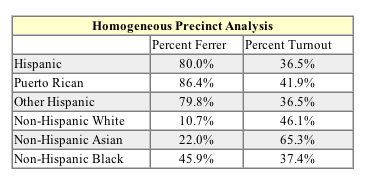
An analysis of voting preference in homogeneous election districts (those with high proportions of a specific ethnic group), reveals that Ferrer did very well among all types of Hispanics.
So why did he lose so badly?
First, turnout was markedly low in Hispanic areas. Second, other groups did not vote for him in high numbers; In areas of high concentrations of African Americans, he received less than half the vote, while he got 22 percent of the Asian vote and only 10 percent of non-Hispanic white voters.
A recently released survey by the New York Immigration Coalition produced similar results.
Characteristics Of Hispanic New Yorkers
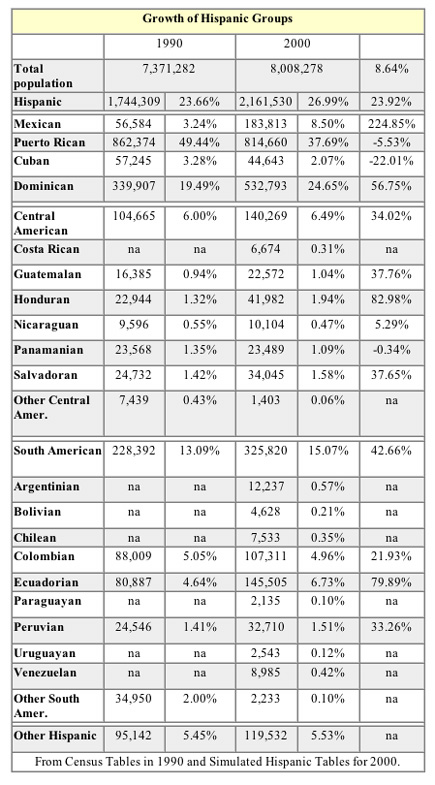
The Hispanic population in New York City is growing rapidly, and becoming more diverse. The Puerto Rican population, which still constitutes the largest Hispanic group in the city, is diminishing. Mexicans have experienced explosive growth. Other groups have grown by at least a third.
When one examines the social and economic position of Hispanics in New York City it is plain that though there are some variations among the groups, they do face similar economic challenges.
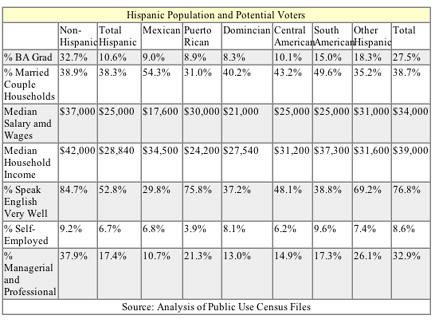
They are less educated, earn less, have lower household incomes than other New Yorkers. A smaller fraction of them speak English "very well." They also are somewhat less likely to be self-employed and much less likely to be employed in managerial and professional occupations.
It is difficult to call them a powerful voting bloc just yet, though, since most of them cannot vote. They are either under 18 or non-citizens.
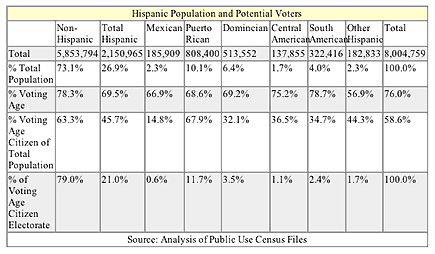
The Hispanics as a group compose about 27 percent New York City's population, but only 21 percent of citizens of voting age population. Indeed, while for non-Hispanics about two-thirds of the population are voting age citizens, for the Hispanic groups the percent is less than half; only about 15 percent of Mexicans in New York are citizens of voting age.
Andrew A. Beveridge has taught sociology at Queens College since 1981, done demographic analyses for the New York Times since 1993, and been in charge of Gotham Gazette's demographics topic page since 2000. The opinions expressed are his alone.Â
Disabled in New York City; Also: Is The City Still Booming?
Over one million New Yorkers between the ages of 21 and 64 are officially disabled, based on the classifications established by the Americans With Disabilities Act.
According to recent Census reports, about a quarter of all New Yorkers within that wide age group living on their own say that a physical, mental or emotional condition lasting six months or more has made it difficult for them to:
Learn, remember or concentrate
Dress, bathe or get around inside the home
Get outside the home alone to shop or visit a doctor’s office
Or, work at a job or business
The most common impairments concern something that affects the ability to work or to go outside the home.
New York City residents who live on their own are more likely to report disabilities than do those who live in the rest of the United States. Plainly those who have difficulties caring for themselves in their own homes also are likely to have difficulties in working and in going out of their houses.
It is the objective of those who provide services and aid to the disabled to make it easier for them to live a full life. For this reason, providing disabled New Yorkers with transportation becomes very important. Though bus-riders in wheelchairs have become a common sight, there is no other mode of transportation in the city that is as accommodating; as a result, too many disabled New Yorkers feel as if they are trapped in their homes.

The areas with the highest rates of disability include the Bronx and Washington Heights, Elmhurst, Bellerose, Brighton, Borough Park, Long Island City and East New York. These areas have high concentrations of minority and poor residents, and some have a high concentration of immigrants.
The disabled are less likely to be white and more likely to be black than the rest of the population. A higher proportion of the disabled are born abroad and do not speak English as their first language. They are less educated: Only 17.3 percent spent four years in college compared to 33.4 percent for the rest of the population at large. They earn less money -- $23,500 median versus $30,000 for the rest, and are more likely to be in poverty.
Is The Boom Over Or Not?
There have been three recent demographic reports that together do not make very much sense.
1. Sam Roberts of the New York Times recently reported that the Census Bureau “ officially listed the city's population at 8,168,338, another record high.” He attributed this to the expert “sleuthing” of city officials.
2. The Pew Hispanic Center study found that the “inflow of newcomers peaked between 1990 and 1995, gradually declined as other states were peaking, and fell again after 2001, to about 90,000 annually, down from 168,000 in 1990. The vast majority of immigration to the state is concentrated in New York City.”
3. A study done I did showed that the top fifth of the population in Manhattan had average incomes over 50 times that of the bottom fifth.
So is the city booming or is the boom over?
During the 1990s, it is plain that high income and the availability of jobs coupled with better counting did lead to the population growth found in New York City. Immigration fueled this growth. Immigrants also tend to accept lower wages and incomes for the same work, so New York City has what some call an hour glass economy -- with a large top and bottom and little in the middle. There are the Wall Street workers, and the people who deliver their food to them. The cooks and the deliverers are immigrants; their customers are very wealthy.
But the Pew study indicates that immigration growth may have ended in the 1990s. So, how can New York City’s population still be growing? The simple answer is that maybe it isn’t – maybe simply the census bureau is doing a better job of counting the population.
Next year, however, we will have the benefit of the first full-blown large scale on-going survey from the bureau. If all goes according to plan, we will know how large is NYC’s population, and how much money New Yorkers are making – whether, in other words, New York is still booming.
Andrew A. Beveridge has taught sociology at Queens College since 1981, done demographic analyses for the New York Times since 1993, and been in charge of Gotham Gazette's demographics topic page since 2000. The opinions expressed are his alone.Â
Who Can Afford to Live in New York City?
Affordable housing has been one of the few concrete campaign issues this year; every candidate seems to have a plan. But is it possible to satisfy the need for affordable housing in New York City? Usually housing is considered unaffordable if it costs a household more than 30 percent of its income. With that definition, about 1.1 million of the 3 million households (36.7 percent) are living in housing that is not affordable to them. In fact, over 600,000 (19.9 percent) spend more than 50 percent of their income on housing. By reviewing housing databased on the U.S. Census from the federal Department of Housing and Urban Development, one can understand just how unaffordable housing is in New York City.
The department has determined that the median income for a family of four in 2000 was $52,100, and it labels income as "low," "very low," or "extremely low" depending on how far income falls below that median.
Slightly less than half of all households in New York City are considered low income (anything $41,700 or below for a family of four), and most of them must pay a large percentage of their total income to obtain housing -- whether they are renting their home, or own it. Almost two thirds of these households spend more than 30 percent of their income for housing. Almost two-fifths spend more than 50 percent on housing.
Housing is even less affordable for those with very low (under $26,050) or extremely low (under $15,650) incomes.
To live in New York City and not spend a tremendous fraction of your income on housing requires the household to have higher income. Even among those with higher incomes, 13.4 percent spend more than 30 percent of their income on housing. (Only 2.9 percent spend more than half). These results and others are in the accompanying table.
|
Cost Burden for Housing for Various Income Levels
|
||||||
|
Rental Units
|
Owner Units
|
Total
|
||||
| Extremely Low Income |
||||||
| Total |
555,562
|
|
72,386
|
|
627,948
|
|
| % Cost Burden >30 % |
395,005
|
71.1%
|
51,466
|
71.1%
|
446,471
|
71.1%
|
| % Cost Burden >50 % |
331,115
|
59.6%
|
44,445
|
61.4%
|
375,513
|
59.8%
|
| Very Low Income |
|
|
|
|
|
|
| Total |
833,300
|
|
137,538
|
|
970,838
|
|
| % Cost Burden >30 % |
594,143
|
71.3%
|
97,920
|
71.2%
|
691,980
|
71.3%
|
| % Cost Burden >50 % |
419,991
|
50.4%
|
74,741
|
54.3%
|
494,839
|
51.0%
|
| Low Income |
|
|
|
|
|
|
| Total |
1,181,311
|
|
250,449
|
|
1,431,760
|
|
| % Cost Burden >30 % |
737,871
|
62.5%
|
159,005
|
63.5%
|
896,630
|
62.6%
|
| % Cost Burden >50 % |
445,396
|
37.7%
|
111,324
|
44.4%
|
556,602
|
38.9%
|
| Non-Low Income |
|
|
|
|
|
|
| Total |
927,421
|
|
661,672
|
|
1,589,093
|
|
| % Cost Burden >30 % |
84,395
|
9.1%
|
128,364
|
19.4%
|
212,938
|
13.4%
|
| % Cost Burden >50 % |
13,911
|
1.5%
|
31,760
|
4.8%
|
46,084
|
2.9%
|
| All Units |
|
|
|
|
|
|
| Total |
2,108,732
|
|
912,121
|
|
3,020,853
|
|
| % Cost Burden >30 % |
822,405
|
39.0%
|
287,318
|
31.5%
|
1,108,653
|
36.7%
|
| % Cost Burden >50 % |
459,704
|
21.8%
|
143,203
|
15.7%
|
601,150
|
19.9%
|
It is important to emphasize that New Yorkers spend a large amount on rent even though New York City is one of the few places in the United States with rent regulation. It also has a very large number of its residents living in public housing or availing themselves of other federal subsidies, and there are also such housing programs for the middle-class as Mitchell-Lama housing. Yet, when compared to the 107 places in the United States that have at least 100,000 housing units, New York City ranks first in the proportion of "low income" residents who pay more than 50 percent of their income for housing costs, and ranks fourth for all residents whatever their incomes who pay more than half, following Miami, Los Angeles, and San Juan, Puerto Rico. The accompanying map shows the distribution of those households who pay more than 50 percent of their income throughout New York City.

Housing cost burdens are highest in areas of most poverty. An earlier columndefined the areas where the poor live.
These areas, include, the following:
• The Bronx, including the South Bronx; part of Harlem;
• Brooklyn, including the area around Bedford Stuyvesant and Flatbush, as well as some parts of Greenpoint and Williamsburg,
• In Queens, some areas of Jamaica.
Many of the residents living in these areas are either in a housing project or have a housing subsidy, yet they still spend a very large amount of their income on rent.
The conclusion is inescapable: Many low income New York City residents cannot afford the homes in which they are living. For all the publicity in the mayoral race given to affordable housing plans, given the scope of the problem, these amount to little more than token developments for a lucky few. Â
Can NYC Profile Young Muslim Males?
Earlier this month Assemblyman Dov Hikind and Councilmember James Oddo both suggested that random searches in the subway weren’t good enough; the police should target particular people. “When we look at the list of the most-wanted people by the FBI in terms of terrorism, they fit a profile," Hikind said. "They look a certain way, they are young, and they come from a certain part of the world.” Oddo was even more explicit in a commentary he wrote for the Daily News: "It is important to acknowledge that nearly every Jihadist who has engaged in terrorist attacks has been a young man who called himself Muslim - the common denominator among the recent bombings in London and Madrid, the 9/11 attacks, the 1993 World Trade Center bombing, the would-be millennium bombers, the destroyer Cole, the embassies in Kenya and Tanzania, Pan Am Flight 103, TWA Flight 847 and the bombing of the Marine barracks in Lebanon.”
But even if the New York Police Department wanted to do so – and it has said clearly that it doesn’t -- profiling young Muslim males is virtually impossible. They are not as easy to spot as Oddo and Hikind seem to think.
Muslims live in most countries throughout the world. Click here for a chart that shows the countries with the highest Muslim population. China ranks ninth. Russia ranks 18th. Indonesia has the most absolute number of Muslims, more than 88 percent of their population is Muslim, and yet there are 30 countries that have a higher proportion of Muslims.
So, some Chinese New Yorkers may be Muslim, while some Indonesians may not be. But let’s take the 25 countries in which at least 50 percent of the population is Muslim. There are 231,000 New Yorkers who claim heritage from these 25 countries, as the following table shows.
| Number and Percent Those With Muslim Country Heritage | ||
|
Heritage
|
Number
|
%
|
| Afghan | 4,448 | 1.93% |
| Albanian | 26,260 | 11.39% |
| Arab | 14,766 | 6.41% |
| Bangladeshi | 32,335 | 14.03% |
| Bosnian | 2,838 | 1.23% |
| Croatian | 11,971 | 5.19% |
| Egyptian | 16,346 | 7.09% |
| Eritrean | 323 | 0.14% |
| Indonesian | 3,601 | 1.56% |
| Iranian | 7,937 | 3.44% |
| Iraqi | 1,006 | 0.44% |
| Jordanian | 956 | 0.41% |
| Lebanese | 11,332 | 4.92% |
| Malaysian | 2,695 | 1.17% |
| Middle Eastern | 1,075 | 0.47% |
| Moroccan | 4,982 | 2.16% |
| Nigerian | 16,904 | 7.33% |
| Pakistani | 40,051 | 17.37% |
| Palestinian | 3,334 | 1.45% |
| Sierra Leonean | 795 | 0.34% |
| Somalian | 17 | 0.01% |
| Sudanese | 943 | 0.41% |
| Syrian | 11,685 | 5.07% |
| Turkish | 12,357 | 5.36% |
| Yemeni | 1,578 | 0.68% |
| Total | 230,535 | |
Some are black, some are Asian; more than 50 percent are white.
Muslims will be much more difficult to pick out from a New York crowd. They are not racially or physically distinct.
But even if one could pick out Muslims as they boarded the subways or airplanes, there is demographic evidence that it would be a wasted effort. When compared with other New Yorkers those whose heritage is a Muslim-majority country are richer, better educated and more likely to be married than other New Yorkers. Most are citizens.
| Characteristics of Those With Muslim Country Heritage | ||
| Ancestry Muslim Country | All Others | |
| Male | 55.8% | 45.6% |
| Black | 9.2% | 28.9% |
| White | 56.8% | 47.3% |
| Asian | 35.6% | 10.1% |
| Other | 14.6% | 17.3% |
| Four Years or More College | 37.3% | 27.3% |
| Married With Spouse | 61.3% | 44.3% |
| Non-Citizen | 43.7% | 19.9% |
| Working | 58.5% | 52.9% |
| Owned House | 25.7% | 30.4% |
| Median Household Income | $40,000 | $37,000 |
This is also true of Arab-American New Yorkers , as I demonstrated previously.
Profiling by origin is the sort of policy that seems appealing during periods of stress and hysteria, but in hindsight is almost always seen as a mistake – such as the internment of Japanese-American during World War II. In this case, however, it wouldn’t even be possible.
Andrew A. Beveridge has taught sociology at Queens College since 1981, done demographic analyses for the New York Times since 1993, and been in charge of Gotham Gazette's demographics topic page since 2000. The opinions expressed are his alone.Â
Upstate And Downstate -- Differing Demographics, Continuing Conflicts
The court fight over funding for public education in New York -- in which a judge agreed that New York City’s schoolchildren were being shortchanged in favor of schools throughout the rest of the state -- is just the latest and most visible example of the old and bitter relationship between upstate and downstate (which means both New York City and its suburbs). New conflicts arise; old ones never seem to die.
A look at the regions’ differing demographics helps explain why this relationship continues to be so difficult.
Downstate Grows, Upstate Does Not
New York City's population accounts for almost half of the state. Throw in Long Island and the northern suburbs (Westchester, Rockland and Putnam) and downstate accounts for almost two-thirds of the state. New York City is the states only "first class city." It is joined by four 2nd class cities, Yonkers (just north of the Bronx), Syracuse, Rochester and Buffalo. The few hundred thousand population of each of these cities is dwarfed by the size of New York City and its suburbs.

While New York City and its suburbs have been growing, the three upstate cities are hemorrhaging population, as is the entire region north and west of the Albany that contains them.

Largely this is due to the loss of the industrial base in Western New York State along with some redistribution of population from the old cities to the surrounding suburbs. These trends also affect the city and its suburbs, but newer economic opportunities in finance, higher technology and corporate headquarters offset the loss of industrial firms. These trends are unlikely to be quickly reversed. Western New York has been losing population for decades, and white and middle class flight to suburbs started even before World War II.
New York City is Diverse, the Suburbs and Upstate are Not
New York City is less and less like upstate New York and less and less like its suburbs. The racial and ethnic composition of the city is very different from the upstate cities, and even more different from the rest of downstate--the city's suburbs and the Hudson River Valley area.
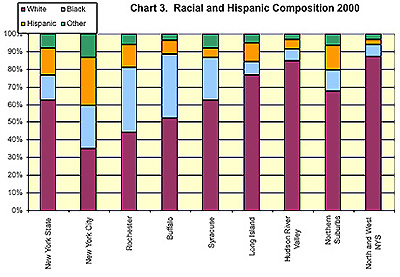
While foreign born residents flocked to the city and suburbs, they have not changed the composition of upstate New York in any substantial way. So though New York City shares the foreign born population with its suburbs, the city's racial and ethnic diversity is much greater than either upstate or the suburbs.
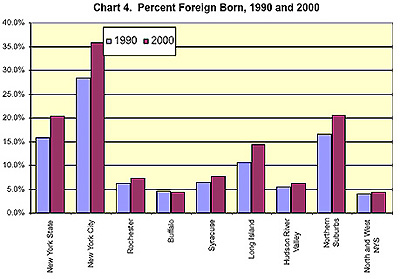
New York is a foreign and minority city with high paying industries such as the financial sector. The rest of the state consists of rural and semi-rural areas mostly inhabited by native-born whites, mostly white suburban communities, and some declining industrial cities.
Not surprisingly, the rest of the state is either jealous of New York City's economic prowess, or suspicious or hostile to its largely minority and foreign residents, or both.
Money and Children Matter
The differences and trends between the city, the suburbs and upstate affect the money available for the city and elsewhere to provide needed services. They also affect where services are needed.
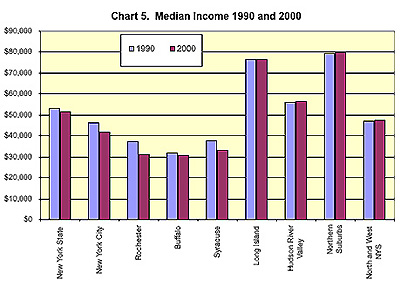
Plainly, resources are not as readily available for any of the cities to finance services such as education, as they are in the suburbs or the Hudson River Valley area. The state does make up some of the funding gaps for the upstate cities, but New York City with more than 42 percent of the city students still waits for the resources promised by the Campaign for Fiscal Equity case. Meanwhile, the suburbs appear, in general, to have adequate resources.
The trends in young and new students mean declines upstate, and increases downstate, most particularly in New York City. In short, there are more educational needs and they continue to grow, in exactly those areas where resources that can be tapped to fund them are lacking. Even in the suburbs, the areas of high need and population growth (e.g. Yonkers) have few available resources. New York City depends the rest of New York State for its funding for needed resources. Its chance of success in getting these resources, even with a popular Republican mayor, seems very slim.
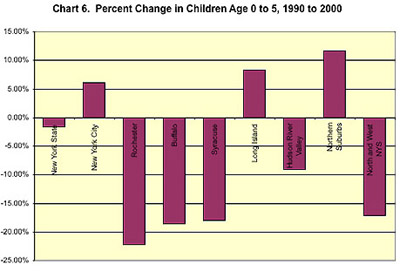
Andrew A. Beveridge has taught sociology at Queens College since 1981, done demographic analyses for the New York Times since 1993, and provides expert testimony on a range of cases, including housing discrimination. The opinions expressed are his alone.
Four Trends That Shape The City's Political Landscape
 The election of Antonio Villaraigosa as Mayor of Los Angeles encouraged Fernando Ferrer's campaign to rally Hispanic support. But it is not a strange kind of vanity that turned Michael Bloomberg into Miguel in some recent ads, as the billionaire's mayoral campaign started in earnest with television commercials in Spanish.
New York City is not like Los Angeles, where nearly 85 percent of all Hispanics are Mexican. There is a dizzyingly diverse mix of Hispanic immigrants in New York, and the various groups may not all respond to one ethnic appeal.
This diverse wave of immigrants to the city is one of four demographic trends that define New York City’s unique political landscape, all of which the candidates must understand, even if they have little power to change them.
Immigrant Waves
New York City's recent population growth was fueled by immigration. Without it, the city's population would not be near eight million. "Without the immigrants,” Mitchell Moss has said, “New York City would be Detroit," a city whose population is lower now than it was in 1930.
During the 1990s New York City continued to draw large numbers of immigrants with a variety of backgrounds, origins and economic status. Unlike virtually every other immigrant area in the United States, immigrants to New York City come from many different places:
- older European countries such as Russia, Italy and Poland;
- the Caribbean, including the Dominican Republic, Jamaica and Haiti;
- Asia, including China, Korea, Pakistan, Bangladesh and India;
- Central and South America, including Mexico, Ecuador and Colombia.
Some of these groups are better educated than others; some gravitate to the professions; some are self-employed. The economic status, family status and ratio of male to female vary widely from group to group. The immigrants in New York City today are much more segregated from the rest of the population and from other immigrant groups than were immigrants at the turn of the 20th century, and even groups from the same nation often gravitate to different locations.
Mayor Rudy Giuliani once remarked that he loved all immigrants, legal or illegal, but in recent years New York City, along with the rest of the country, has reversed that inclusive sentiment. After 9/11, the climate for undocumented foreign born, foreign students and foreign workers in New York City (as elsewhere) has worsened. Entering the country, either legally or illegally has become much more difficult, and undocumented immigrants have a harder time living here since they can no longer open bank accounts or obtain driver's licenses. It is possible that the immigrant waves have now slowed.
Racial Segregation and the Black Middle Class
The African Americans in New York City are highly segregatedfrom other groups. Within this segregation, there is a burgeoning black middle class in South Eastern Queens as well parts of the Northeast Bronx and recently the beginnings of one in parts of Harlem. Blacks in Queens have incomes at least on par with the whites living there, and the neighborhoods around St. Albans, Cambria and Laurelton are especially affluent and virtually 100 percent black. These areas contain highly mobilized and affluent potential supporters for any mayoral campaign. Many candidates have already recognized this constituency and sometimes visit the black churches in Queens on Sunday mornings in search of votes and contributions.
Rising Income Inequality
Areas of wealth exist around the boroughs, but New York City and especially Manhattan remain economically stratified with income inequalitydwarfing that of most third world countries. Neighbors and peers of Michael Bloomberg in the Upper East Side zip code of 10021 supplied the most political donations to both the Bush and Kerry campaigns in 2004 of any zip code in the country. The rich folks constituting the top 20 percent of Manhattan have about 50 times the income (over $350,000 on average) of the poor folks in the bottom 20 percent. Income inequality within the very small geographic area of Manhattan is a growing trend, and it seems there is little New York City can do about it.
Middle Class Exodus of People and Jobs
Many people of the middle and upper middle class are moving outside of New York City into the New York metropolitan area. The movement of people and jobs undoubtedly increased in the aftermath of 9/11, but the trend began in earnest after World War II, especially the more affluent who sought employment, housing, city services and improved quality of life outside of city limits.
New York City is increasingly the home of the foreign-born, as well as native-born African Americans and Hispanics. Such residents, in fact, are more and more in need of primary, secondary and higher education, decent health care, reasonable employment, public transportation, etc. While the wealthy take care of themselves and the middle class leave New York City, new residents and those on the bottom become the core recipients of vital city services and those most affected by changes to them. Yet, the city struggles to fulfill these needs, despite its disproportionate tax burden. The Campaign for Fiscal Equity school funding case, the abolition of the commuter tax, the crumbling city infrastructure and the big development plans both for Ground Zero and for the West Side contribute to the impression that New York City residents and their needs are subordinate to the interests of suburban and upstate residents.
It may not matter much whether Gifford Miller, Anthony Weiner, Virginia Field, Freddy Ferrer or Michael Bloomberg is elected, or which ethnic, immigrant or racial groups the candidates mobilize. New York City's needs will remain the same, and these same four trends will continue to shape the issues. Managing or overcoming the negative impacts of these trends will prove a daunting task for the next mayor, whoever that turns out to be.
Andrew A. Beveridge has taught sociology at Queens College since 1981, done demographic analyses for the New York Times since 1993, and provides expert testimony on a range of cases, including housing discrimination. The opinions expressed are his alone.
New York's Responders and Protectors
They stand apart, the 70,000 or so people hired to respond to crises in the city, protecting the lives and property of New Yorkers – police officers, firefighters, corrections officers, FBI agents, and so forth. To many, especially since September 11th, they stand apart as heroes. To some, they stand apart as villains. But, looking at statistics from the 2000 Census, they stand apart from the average New Yorker in other ways as well. They are, for example, whiter, less educated, less likely to live in the city, and also more affluent than the average New York worker.
The Numbers
According to the Census, and departmental websites, there were about 40,000 police, and 11,000 fire fighters (including supervisors, but not including civilians), who were employed by and work in New York City. The census also found about 8,000 local corrections officers, as well as 11,000 protectors and responders employed by the state or Federal government working in the city. These presumably include officers from the Port Authority, the Federal Bureau of Investigation, the Drug Enforcement Agency and other law enforcement agencies. There is substantial variation among these different workers, but, as a whole they are quite different from other city workers, including those who work in other agencies of local government.
Where They Live
About half the fire fighters, and two-fifths of the police, live outside the city, in areas very different from the neighborhoods they service. By contrast, one-sixth of other government workers and about one-fifth of all New York City workers live outside the city. As a result many more of the responders and protectors are more likely to own their own homes, be married and live with their spouses (firefighters especially) and drive to work.
|
Characteristics of New York City Responders and Protectors and Other Workers
|
||||||
| NYC Police | NYC Fire Fighters | NYC Corrections | State Federal Protectors | Other Local Government Employees | All Other Workers | |
| A. Live and Work | ||||||
| % Live in NYC |
60%
|
50%
|
73%
|
58%
|
84%
|
78%
|
| % Drive to Work |
77%
|
87%
|
74%
|
68%
|
48%
|
31%
|
| % Married with Spouse |
56%
|
70%
|
52%
|
55%
|
49%
|
47%
|
| % Homeowners |
68%
|
83%
|
68%
|
66%
|
52%
|
44%
|
| B. Sex | ||||||
| % Male |
81% |
99% |
66% |
79% |
42% |
55%
|
| % White |
71%
|
93%
|
38%
|
69%
|
49%
|
56%
|
| C. Background | ||||||
| % Hispanic |
19%
|
6%
|
16%
|
14%
|
18%
|
20%
|
| % Black |
19%
|
4%
|
53%
|
31%
|
34%
|
19%
|
| % Native Born |
90%
|
93%
|
84%
|
88%
|
70%
|
59%
|
| % Born New York State Born |
81%
|
87%
|
71%
|
69%
|
55%
|
40%
|
| % Irish Ancestry |
27%
|
46%
|
7%
|
20%
|
8%
|
9%
|
| % Italian Ancestry |
23%
|
31%
|
16%
|
17%
|
12%
|
11%
|
| D. Education and Income | ||||||
| % High School Grad |
99%
|
100%
|
100%
|
100%
|
94%
|
89%
|
| % College Grad |
26%
|
29%
|
14%
|
34%
|
48%
|
40%
|
| Median Age |
35
|
39
|
39
|
37
|
43
|
38
|
| Median Personal Income |
$54,200
|
$62,000
|
$52,000
|
$50,000
|
$35,000
|
$31,000
|
| Median Household Income |
$83,000
|
$84,000
|
$74,500
|
$80,000
|
$65,200
|
$65,400
|
Race, Gender, Ethnic Origin
Unlike other workers, they are predominantly male, virtually all male in the case of the fire fighters. A higher proportion of the responders and protectors are native born, and a large fraction were born in New York State. A lower proportion of the police and especially the fire fighters are black than other protective workers, and a lower proportion of the fire fighters are Hispanic. Perhaps, it is not surprising that many fire fighters wanted to wear Tam O'Shanters again this year in the St. Patrick's Day parade, since almost half claim Irish heritage. The police, the fire fighters and the state and federal protective workers are more likely to be Irish than workers as a whole. Police officers and fire fighters also are more likely to claim Italian heritage.
New York City's fire fighters are virtually all white and all male. Indeed, the United States Department of Justice recently launched an investigation into hiring discrimination in the department. Now the department plans to spend $1.4 millionto do something about it.
Education And Income
Though virtually all protective workers are high school graduates, a lower proportion than other city workers and other workers in general have completed college. The protective workers do earn substantially more than other local government workers, or city workers as a whole, and their households also are much more affluent. In terms of pay and benefits, the protective occupations are quite well paid, and it is not surprising they are sought-after positions.
Analysis Notes
This analysis was done by using the occupation, industry, employer and place of work codes for the individual records in the five percent Public Use Micro-Data Sample (PUMS)from the 2000 Census, which provides individual and household level data. All figures are based upon this five percent weighted sample. The New York City Fire Department and New York City Police Department can be distinguished in this manner. Obviously there may have been some changes since April 2000 however the number of police and fire fighters estimated by the Census sample is almost exactly what the two departments reported in that year.
Andrew A. Beveridge has taught sociology at Queens College since 1981, done demographic analyses for the New York Times since 1993, and provides expert testimony on a range of cases, including housing discrimination. The opinions expressed are his alone.Â
Who Got The Death Penalty
New York State's death penalty law was in effect just short of nine years before the Court of Appeals struck it down for its "coercive jury instruction" last June.
While Governor George Pataki says he wants the death penalty restored, it is not clear that the death penalty will be made legal once again in New York. Opponents of capital punishment make many arguments - that it does not deter crime, that it is immoral for the government to kill people, even that it is expensive: before it was rule unconstitutional, only .11 percent of those arrested for murder faced the death penalty, and yet the costs of administration were in excess of $250 million per year. But the most passionate argument is probably the uneven way in which the death penalty is applied.
In New York State, those people who committed murders outside New York City, and those killing white victims, were much more likely to have been sentenced to death.
How Many Arrested, How Many Sentenced
Since 1995, when the death penalty was restored in New York, 6,545 arrests have been made for murder, according to statistics compiled by the Capital Defender Office.
Of these, 500 resulted in first-degree murder indictments.
Of these 500, 58 resulted in a "death notice" being filed - a notification by the prosecution that it may seek the death penalty.
Of these 58: 9 cases are still pending, 27 resulted in life without parole from a plea bargain; one defendant committed suicide in jail; one death notice was withdrawn, five were given very long sentences; and 15 so far have been given trials.
Of the 15 who have been given trials, One's sentence is still pending; one was acquitted; one was sentenced to 115 years to life; five were sentenced to life without parole
And seven defendants were sentenced to death.
All seven are still alive.
Where You Kill Makes A Difference
The chance of a first degree murder indictment turning into a death notice varies depending on where one is accused of doing the crime. Only six percent of the murder one indictments in New York City resulted in a death notice, compared to 23.1 percent upstate.
[if supportMisalignedColumns] [endif]
|
Murder Arrests, Indictments, Death Notices and
Death Sentences by Region |
||||||||
|
Region
|
Murder 1 & 2 Arrests*
|
Murder 1 Indictments
|
Murder 1 Indictments (% of Murder 1 & 2 Arrests)
|
Death Notices
|
Death Notices (% of Murder 1 Indictments)
|
Death Sentences
|
Death Sentences (% of Murder 1 Indictments)
|
Death Sentences (% of Death Notices)
|
|
New York City
|
4661
|
299
|
6.4%
|
18
|
6.0%
|
2
|
0.7%
|
11.1%
|
|
Nassau, Rockland, Suffolk and Westchester
|
553
|
58
|
10.5%
|
4
|
6.9%
|
3
|
5.2%
|
75.0%
|
|
Upstate - Rest of State
|
1331
|
156
|
11.7%
|
36
|
23.1%
|
2
|
1.3%
|
5.6%
|
|
Total
|
6545
|
513
|
7.8%
|
58
|
11.3%
|
7
|
1.4%
|
12.1%
|
|
* Arrest data includes only those murders committed on or after 9/1/95 and excludes defendants under 18
|
||||||||
|
Source: Capital Defender Office
|
||||||||
The chance of being convicted and sentenced to death is much greater in the New York suburbs than elsewhere. (Given the few death sentences one should be cautious about drawing inferences about patterns, since the three death sentences in the suburbs all come from Suffolk and from three quite sensational cases. However, the use of a death notices certainly enhances the prosecution's chances of getting a long sentence from a plea bargain).
Race of Defendant, Race of Victim
Those accused of killing a white victim are more than twice as likely to receive a death notice than are those accused of killing only a non-white victim. Similarly they are twice as likely to go to trial and over five times as likely to receive the death sentence. These figures are statistically significant according to an analysis by David Baldus, an expert on the application of the death penalty.
|
Race of Victim and Race of Defendant and Capital Cases
|
|||||||
| Race of Victim | Murder 1 Indictments | Death Notices (% of Murder 1 Indictments) | % of Murder 1 Indictments | Death Sentence Trials | Death Sentence Trials (% of Murder 1 Indictments) | Death Sentences |
Death Sentences (% of Murder 1 Indictments)
|
| White |
152
|
30
|
19.7%
|
8
|
5.3%
|
5
|
3.3%
|
| Non-White |
344
|
28
|
8.1%
|
7
|
2.0%
|
2
|
0.6%
|
| Race of Defendant |
|||||||
| Black |
293
|
29
|
9.9%
|
8
|
2.7%
|
3
|
1.0%
|
| Non-Black |
207
|
29
|
14.0%
|
15
|
7.2%
|
7
|
3.4%
|
| Source Capital Defender Office from Baldus Testimony, Modified |
265.4%
|
|
330.3%
|
||||
Because of the disparity in the application of the death sentence upstate versus downstate, and given the demography upstate versus downstate, blacks accused of murder are much less likely to receive the death sentence.
Andrew A. Beveridge has taught sociology at Queens College since 1981, done demographic analyses for the New York Times since 1993, and provides expert testimony on a range of cases, including housing discrimination. The opinions expressed are his alone.Â




